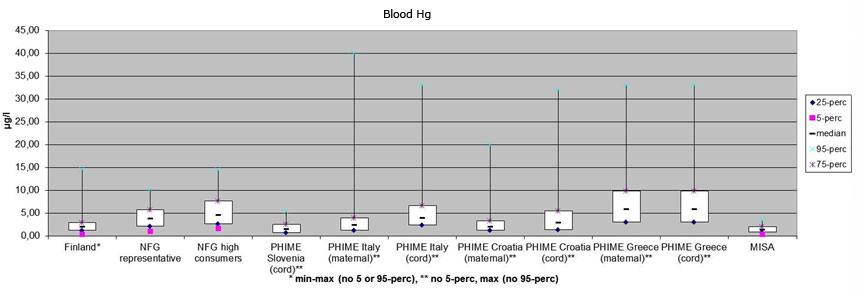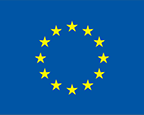Comparison between Arctic cohorts and Mediterranean cohorts
PCBs
PCB-153 is among the most prevalent PCBs found in human populations and as thus has been an indicator for PCB. One of the problems in using one PCB as an indicator is that the metabolism and half-life of different congeners, and consequently fate in nature and humans vary.
Exposure of PCB-153 was compared for a number of Arctic and Mediterranean cohorts. The results, see figure below, indicate that PCB-153 exposure was highest among participants in the Norwegian Fish-and Game study, followed by the Spanish INMA and the Norwegian MISA study. However, although the same congener has been measured, higher serum concentration in the Norwegian fish and Game study participants can be expected due to higher age among the participants (median: 55 years, range: 21-80 years). Furthermore, participants in the high consumer group were invited due to high consumption of food that generally contains higher levels of POPs compared to other food groups. Interestingly, the mean and upper range of exposure was lower among the MISA participants than in the INMA cohorts (both in maternal and cord blood). The sampling period was also in the same range (INMA 2004-2008, except Menorca which was sampled 1997-99, MISA 2007-2009). Thus, this might indicate that women in fertile age living in Spain have higher PCB-exposure than women in the Northern part of Norway. The median fish consumption among children from Menorca was approximately 2 times/week, while the MISA women consumed fish 3-4 times/week. Thus, one could suspect higher concentration of PCBs in food consumed in Menorca compared to Arctic Norway.

Polybrominated diphenylethers (PBDEs)
Different commercial congener mixtures of PBDEs have been extensively used as flame retardants in different products. Of these, BDE-47 is the congener most often detected, and at highest concentration in food, human serum and breast milk. BDE-47 can be used as an indicator of total PBDE- exposure, but like for PCBs, there are local and individual variations.
A summary of the BDE-47 exposure data from different groups studied in the ArcRisk can be seen in the figure below. The BDE-47 exposure was highest in the INMA cohort from Valencia, followed by participants in the Norwegian Fish and Game study (NFG). The reason for the larger distribution in Valencia compared with the NFG-participants cannot be explained by higher fish consumption in Valencia, although fish and other seafood are the major dietary sources to PBDE exposure (EFSA CONTAM, 2011). Available information from Arctic Canada (Donaldson et al., 2010) indicates higher BDE-47 concentrations in the Canadian population compared to European cohorts.

Mercury
Mercury have been analysed in maternal blood, cord blood and hair from the ArcRisk study groups, see figures below. Mercury concentration in humans from Arctic Canada is variable and has decreased with time (Donaldson et al., 2010). The concentrations were highest in Nunavik, followed by Baffin region and the Inuvik region. The concentrations in people from Nunavik have been several times higher than in the ArcRisk study groups but appears to have declined to the same range as in the Norwegian (high consumers) and in Greece. Russian study groups were also within similar concentrations/slightly higher compared to the NFG-study high consumers (Dudarev 2004). However, concentrations in pregnant women were considerably lower, and in the same range as in maternal blood from Italy, Croatia and Arctic Norway, and lower than in maternal blood from Greece.
Together with variation in fish consumption, the choice of fish species and local variability in Hg-concentration in fish are probably the most important determinants of Hg-exposure. In addition, sea mammal consumption in indigenous population groups is of importance.























